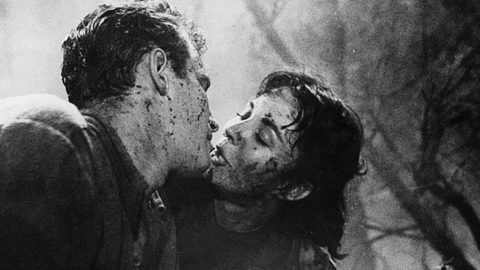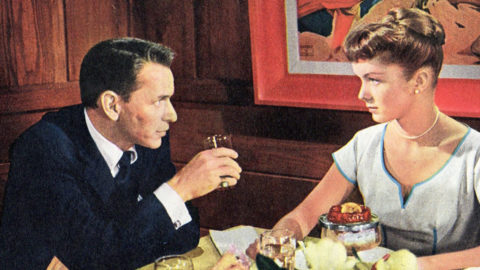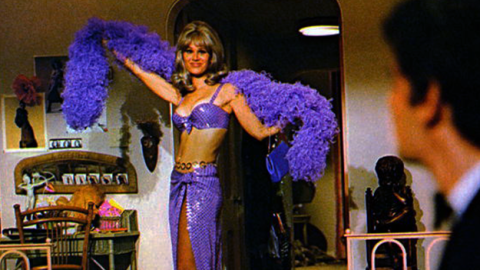TCM Diary: Love Me or Leave Me
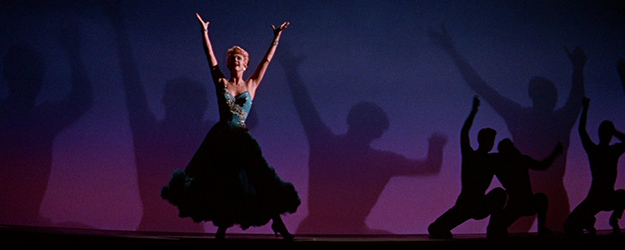
Love Me or Leave Me has slipped through the cracks of serious critical consideration, despite its box office success, multiple Oscar nominations, and the draw of two gigantic stars like Doris Day and James Cagney. Even at the time, contemporary reviewers damned with faint praise. Bosley Crowther wrote in his New York Times review: “To say that the Metro production, in color and Cinema-Scope, is expensive and atmospheric of the era of night clubs and booze is simply acknowledging the dependable, and to say that Charles Vidor’s directing is perceptive of the values in the story is to note what’s expected of him.” Being “perceptive of the values in the story” is nothing to be sneezed at, however, and “dependable” directors do a lot of terrific work. Love Me or Leave Me doesn’t fit into an auteur theory bucket since Vidor, mostly remembered for turning Rita Hayworth into a supernova with Gilda—didn’t “mark” his films with a particular stamp. He wasn’t prolific, but his career included screwball comedies, horror films, crime stories, and musicals, and films as diverse as Ladies in Retirement, Cover Girl, Gilda, Farewell to Arms, and Love Me or Leave Me. Doing what was “expected of him” yielded wonderful results.
Love Me or Leave Me is the story of Ruth Etting, a singing star in the 1920s and ’30s, who got her start in Chicago nightclubs, which is where local gangster Martin Snyder first saw her. Snyder had ties to show business, and took over managing her career. The two married in 1922. He was a violent and controlling man, with a pronounced limp from a childhood accident, and later she said that she stayed with him out of a mixture of fear and pity. In October, 1938, separated from Etting and insanely jealous, he shot her new lover (and piano accompanist) Myrl Alderman. Alderman did not die from his wound, and he and Etting married in December 1938 (and stayed married until his death in 1966).
The script for Love Me or Leave Me by Isobel Lennart and Daniel Fuchs sticks pretty closely to the facts, with some minor whitewashing of realities not acceptable in 1950s film. Love Me or Leave Me is a strange film, a hybrid of conflicting genres which never quite merges into a whole, but is part of the film’s unnerving power. In its own 1950s way, Love Me or Leave Me is as frightening as Bob Fosse’s Star 80, about a similar type of relationship. While James Cagney and Doris Day both give tour de force performances, it’s a career best for Day. Cameron Mitchell finds a lot of subtlety in the thankless role of Johnny, the piano player who takes a bullet, segueing from being just another guy making a pass at her to a platonic friend and supporter to worried witness.
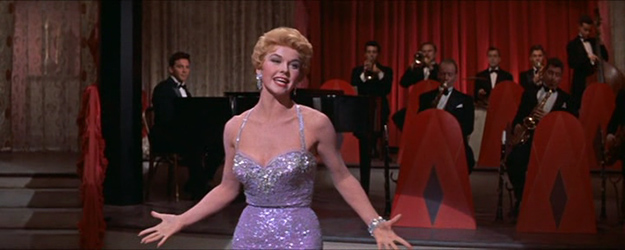
It was Cagney’s idea to cast Day. Doris Day was a blonde thoroughbred, and a legitimate triple-threat, but underrated as an actress (and remains so now—where’s her Lifetime Achievement Award?). Nothing Day had done up to that point challenged her like the role of Ruth Etting. The following year, in Hitchcock’s The Man Who Knew Too Much, she got the chance again, and the excruciating scene where she fights against the effects of the sleeping pills is a high watermark in her career. Love Me or Leave Me is filled with musical numbers (all of them were Etting hits, except for two new songs written for the film.) The songs range from quiet ballads to huge production numbers with tuxedoed chorus boys. Each song is placed in the story to reflect on the action (“Ten Cents a Dance,” coming right after Ruth caves in and marries Martin, is brutal commentary.) Vidor, gifted with musical numbers, sometimes knew the best choice was to plant the camera in one spot, and let Day sell it. She does.
But it is in the emotional arc of the character where Day’s work really shines. From the first moment she is seen on screen, kicking the shins of a dance partner who gets “fresh” with her, we know who she is. When Snyder appears at her dressing room door, she does not cringe from his leer, but barks, “Gotta good look?” It’s clear—even though there’s no language to support it—that Ruth has been “messed with” by men probably from the moment she developed breasts. Watch her body language when men touch her. She’s been pawed her whole life. She sees Martin for who he is, but she’s tough, she thinks she can handle him. She wouldn’t be the first woman to make such a grave error. Ruth knows she owes Martin her career, and he guilts her into staying with him, marrying him (in a violent scene, it’s suggested he rapes her into submission.) Martin doesn’t “gaslight” Ruth. Instead, he breaks her spirit (and then hates the “broken” Ruth he’s stuck with). Day masterfully tracks this journey: how the light goes out of her eyes, her posture collapses, her speaking voice flattens. She is a weak animal subdued by a strong one.
Cagney made his name playing tough guys during his years at Warner Brothers. But Martin is not a retread of Cody Jarrett or Tom Powers. When he first appears, coming into the nightclub where Ruth works as a dance “hostess,” his shadow is seen before he is, so gigantic it looms over an entire wall. Cagney comes around the corner, dwarfed by his own shadow. This evocative shot has both visual and thematic power—evidence of how carefully Vidor worked as a director, in particular with character entrances: Rita Hayworth’s entrance as Gilda remains one of the most famous character introductions in cinema! Martin is a short insecure man who will do whatever it takes to seem bigger than he is. Cagney’s physical work with the limp is phenomenal. For such a graceful man, he is believably awkward, lumbering across rooms, hauling himself up stairs. Cagney shows us Martin’s insecurities, without once making a plea for our sympathy.
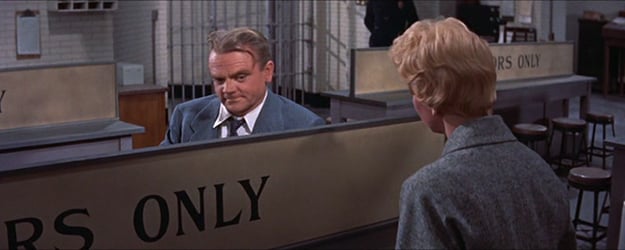
Day and Cagney are both so stripped bare here, and their scenes together shatter the conventional musical genre and move into truly harrowing territory. Their fights shiver with a real sense of danger. During one dreadful confrontation, Ruth screams at Martin, “Do you think you own me?” and the emotion is a tidal wave rising from Day’s toes. Cagney’s genius is in allowing us to see that underneath Martin’s rage is self-loathing: What’s wrong with me? Why doesn’t she like me? As an actor, you are required to reveal your ugliness, your shame, your pain, your pettiness. Cagney’s willingness to do that is what makes the performance a towering one, and what makes Cagney Cagney. He was nominated for Best Actor for his performance. Other nominations for the film included Best Screenplay, Best Sound, Best Original Song, and Best Score. Daniel Fuchs won for Best Story (a category eliminated the following year). Doris Day wasn’t nominated at all.
In 2007, Brian May, lead guitarist for Queen, wrote a love letter to Doris Day’s singing voice on his blog, culminating with this impassioned plea: “She is technically unmatched, adorable, mind-blowingly expressive, and probably the best interpreter of a song I ever saw. I just hope she knows how much she is still loved and respected. Will somebody please tell her?”
Sheila O’Malley is a regular film critic for Rogerebert.com and other places including The Criterion Collection. Her blog is The Sheila Variations.



